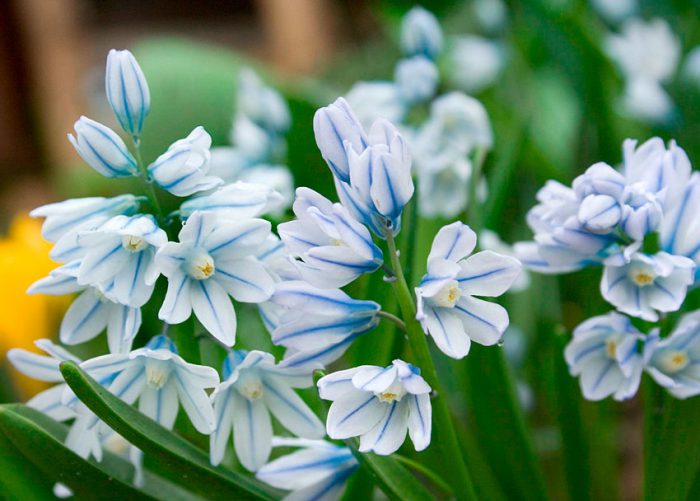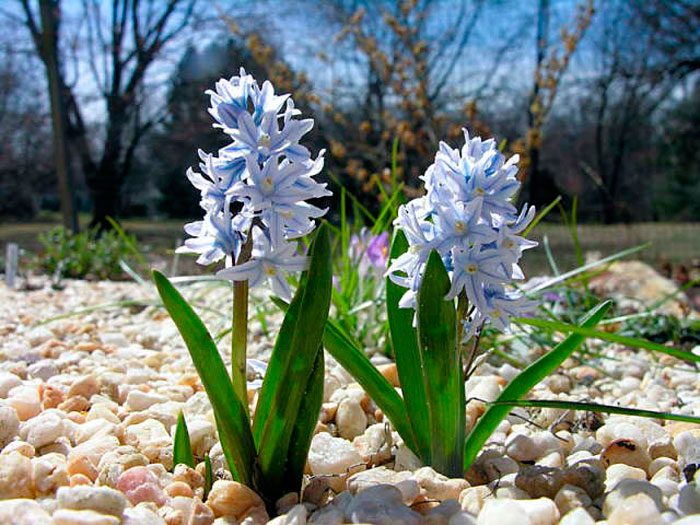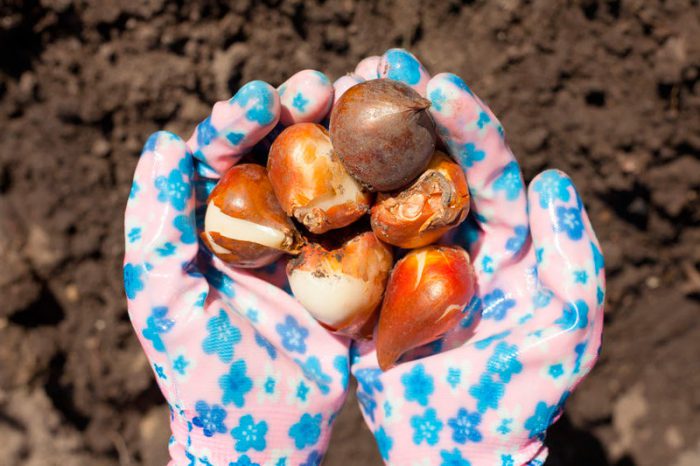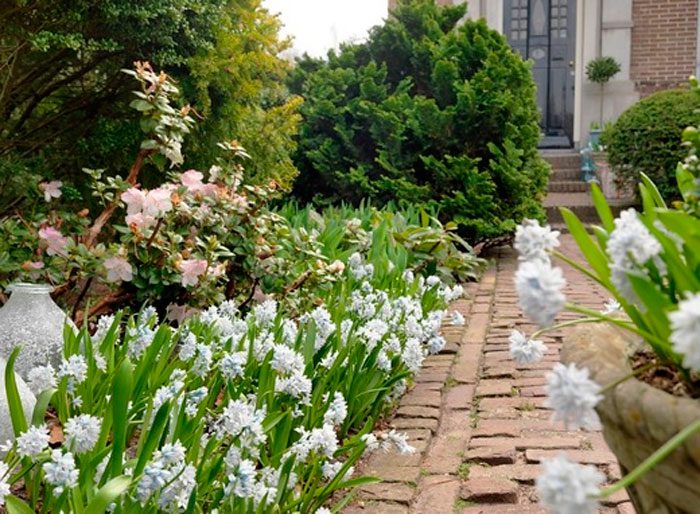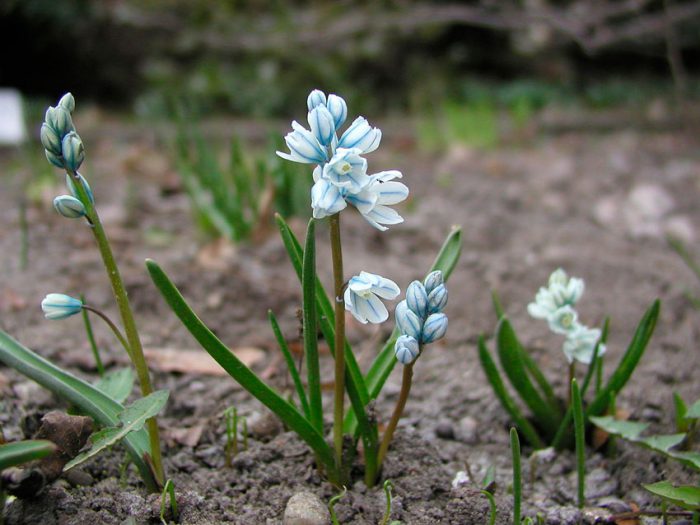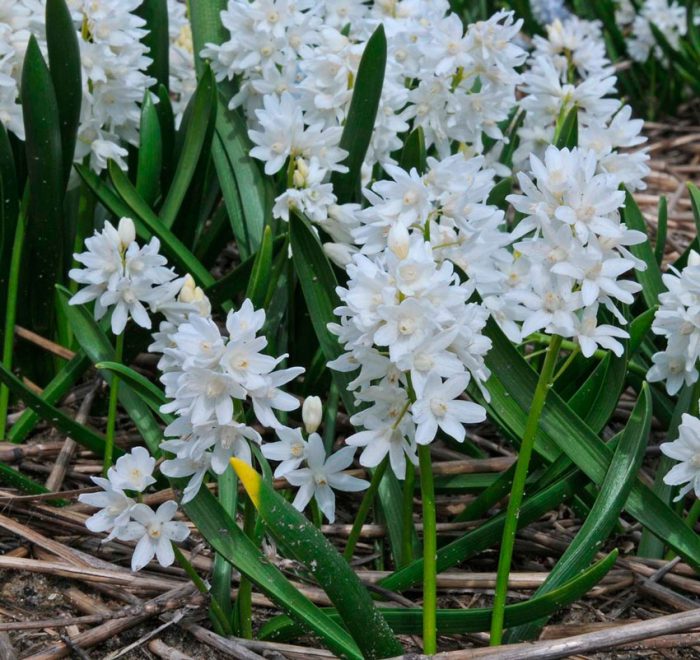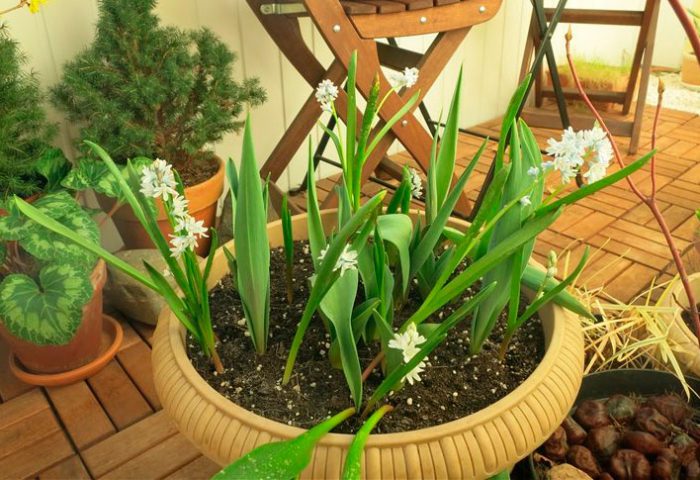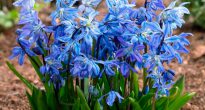The plant Pushkinia (Puschkinia) is a representative of the genus of the subfamily hyacinths, of the asparagus family, but in some sources such a flower is included in the lily family. This flower was named in honor of Musin-Pushkin, who was a Russian mineralogist and chemist, as well as a member of the Royal Society of London, it was he who first collected data from the flora on Ararat. Pushkinia is also sometimes called the dwarf hyacinth, because these plants are very similar in appearance, as they are the closest relatives. This genus unites only 2 species and several varieties. In nature, they can be found in Asia Minor and Asia Minor, as well as in the Caucasus, while Pushkinia prefers to grow in mountain meadows, among shrubs and on damp rocky slopes.
Content
Features of Pushkin
Pushkinia is one of the most spectacular spring primroses. The height of the bush varies from 15 to 20 centimeters. Such a herbaceous plant is an ephemeroid, its ovoid bulbs cover thin outer scales of brown color. At the base of the stem there are 2 or 3 dark green leaf plates of a belt-like linear shape. The racemose inflorescences consist of bell-shaped flowers of white or light blue color, which have an unobtrusive unpleasant aroma. In some cases, flowering begins several days after the appearance of leaf blades. The fruit is a juicy box, inside which are pale brown seeds that are round in shape.
Despite the fact that this plant can hardly be called large, it has a very high decorative effect. Pushkinia looks good in rockeries, as well as in small backyard gardens, planted together with other primroses or perennials.
Planting a gun in open ground
What time to sow
If you decide to grow such a primrose from seeds, then you should be patient. The fact is that when propagated by the seed method, Pushkin begins to bloom only in the fourth year of life. Even the first seedlings appear about 30 days after sowing. But vegetative propagation is also ineffective. Seeds are sown in open soil immediately after harvest, and this time, as a rule, falls in June.Sowing can also be carried out from the second half of September to the twenties of October, but in this case, freshly harvested seeds will need to be placed on the refrigerator shelf before sowing, while taking care that they do not dry out.
Seeding features
If the seeds are sown under the winter, then they will be able to undergo a full-fledged natural stratification, and this has a very good effect on the growth, development and health of the plant. But before you start sowing, you need to prepare the site. To do this, care must be taken to ensure that there is good drainage, in the event that the soil is too dense, sand, peat or leaf humus are added to it to loosen it. For sowing, you can choose a well-lit or slightly shaded area. It is necessary to deepen the seeds into the soil by at least 5 centimeters, then for the winter the surface of the site should be covered with a layer of mulch (peat).
Pushkin care in the garden
You need to take care of the Pushkinia in the same way as for other flowers growing in the garden. So, it needs to be systematically watered, loosened the surface of the soil, remove weeds, feed it in time, and also promptly remove the inflorescences that have begun to wither. To significantly reduce the number of watering, weeding and loosening, it is necessary to cover the surface of the site with a layer of mulch (peat). In order for these flowers to develop normally and have a very effective appearance, you need to take care of them correctly and systematically, for example, if you do not remove the weed in time, it will quickly "crush" the fragile little push.
Top dressing is done in early spring. To do this, use a complete mineral fertilizer (for example, nitrophoska), which is evenly distributed over the surface of the site, taking from 50 to 60 grams of substance per 1 square meter (about a couple of handfuls). In this case, feeding must be done even if there is snow. After the soil thaws in April and shoots appear, it will be necessary to loosen the aisles.
If the spring is dry, then pushkinia will need to be watered, and it should be borne in mind that it especially needs watering during the period of intensive growth of leaf plates. In summer, it is imperative to carry out timely weeding and loosening of row spacings. In the event that the bush turns yellow earlier than it should be, or it is affected by a disease, it must be dug up and must be destroyed.
It is quite simple to grow Pushkinia, while it will surely give you a lot of pleasure during flowering in the spring.
Reproduction of Pushkinia
Growing Pushkin, one must remember that it needs systematic transplants. The fact is that an adult bulb grows up about 5-7 children of various ages within 4–5 years. These plants become very crowded, which significantly reduces their decorative effect. During transplantation, the children must be separated from the mother's bulb. Thus, the vegetative reproduction of Pushkinia occurs. How to propagate it in a generative (seed) way is described above. The nest of bulbs must be dug up and the children must be separated from the parent bulb. Then they are removed for storage, and with the onset of the autumn period they are planted in a permanent place, while a distance of at least 10 centimeters must be kept between the bulbs. Experts recommend dividing the bulbs once every 5 or 6 years.
It should be remembered that it is necessary to dig up the bulbs on time. The bulbs dug out ahead of schedule are very poorly stored. If they are removed from the soil later than the due date, then most of the children will remain in the ground, since at this time they are extremely easily broken off from the mother's bulb. The time when you should start digging a bush is determined by the state of its leaves. As soon as they dry up, you should start transplanting and dividing.The bulbs must be removed from the soil and put in the shade to dry, and then the remnants of the earth and old roots must be removed from them. Separated babies should be sorted by size. Large bulbs can be planted in open soil in a permanent location, or used for forcing indoors. Small bulbs need to be planted in a training bed. All sorted bulbs should be placed in slightly damp sawdust or peat and stored in a well-ventilated cool room. There they should be stored until planting.
Pushkinia is planted in open ground in the autumn. Planting depth depends on the size of the bulb and can vary from 5 to 7 centimeters, while a distance of at least 10 centimeters must be maintained between the holes.
Such a flower is able to reproduce well enough by self-seeding. This method of breeding Pushkinia is an excellent alternative to seed, the main thing is that one must not forget to control this process.
Pests and diseases
This plant can suffer from those diseases that affect small-bulb and bulbous plants. For example, if spots of brown color appear on the ground parts of the bush, this means that it is affected by gray rot, the causative agent of which is the fungus Botrytis. This is a rather dangerous disease, because this fungus is omnivorous, and it can quickly infect other plants. For prophylactic purposes, experts recommend, watering the bush, to try to prevent liquid from falling on the surface of the foliage, not to overfeed the gun with nitrogen, and also to dig up and destroy the affected specimens as soon as possible. At the initial stage of the development of the disease, agents such as Champion, Bordeaux liquid, Topaz or Cuproxat are used to destroy it. If the specimen is very badly affected, then Skor, Previkur or Fundazol are used to process it.
It is also quite dangerous that the plant is damaged by bulb rot, while the causative agent of such diseases is a variety of fungi. In infected bushes, the base of the leaf plates turns yellow, then the disease penetrates into the bulb itself, from which specks of a brownish-red color are formed on its surface. This leads to the death of the bulb. This infection can persist in the soil for a long time. In order to save the plant, it must be treated with a remedy containing copper in a timely manner. Before planting an onion, it must be thoroughly examined, if it raises the slightest doubt, then it is better to destroy it.
Pushkinia is also susceptible to a disease such as achelenchoides. Because of it, the scales of the onions become brown, ring rot appears. Also, near the bottom on the surface of the bulb, pale brown necrotic specks are formed. In the affected bush, there is a lag in development and a loss of decorative appearance. All diseased bulbs must be burned, and before planting healthy ones, they are immersed for a while in slightly hot (about 43 degrees) water.
The bulbs of the plant can damage the mice, in order to drive them away, bait with poison is laid out on the site. Also, the danger for such a flower is represented by root meadow mites, which penetrate into the bulbs, gnawing their bottom. They eat up the inner scales, causing the bulbs to rot or dry out. For preventive purposes, the bulbs should be treated with insecticidal preparations before planting. If there is a serious danger of infection, then the pushkin is treated with the same drugs on the site.
Pushkinia after flowering
In autumn, after sowing seeds or planting bulbs in open soil, a dormant period is observed in Pushkinia. At this time, the plant should be prepared for wintering; for this, the site is covered with humus (layer thickness from 20 to 30 mm) or peat (layer thickness from 50 to 70 mm).In spring or summer time, it is not necessary to remove mulch from the site, because it protects the plants from the rapid growth of weeds and from drying out.
Forcing Pushkinia
Pushkinia is perfect for forcing indoors, and its beautiful flowers can be seen already in winter. Several bulbs are selected for forcing. They are planted in November in a pot with a diameter of 13 to 15 centimeters and a height of about 7 centimeters. A soil mixture is poured into it, which includes leaf humus, river sand and sod land, taken in a ratio of 1: 1: 2. The container is removed for 8-10 weeks in a dark basement, where the air temperature should not exceed 10 degrees, and the humidity should be about 85-90 percent. Then she is taken out into a well-lit room, in which it should not be warmer than 15 degrees, and the flower will need to be watered. Flowering begins after 14–20 days. It is recommended not to throw out the faded bulb, because if you take proper care of it, it will delight you with its spectacular flowers again and again.
Types and varieties of Pushkinia with photos and names
There are 2 types of Pushkinia cultivated: Proleskidnaya and Hyacinth.
Pushkinia hyacinthus (Puschkinia hyacinthoides)
Under natural conditions, this kind can be found on the mountain slopes of the Eastern Transcaucasia and Northern Iran. Such a very beautiful small plant has fleshy linear leaf plates that reach 15 centimeters in length and have a centimeter width. The diameter of the bulbs is about 20 mm. In height, powerful peduncles reach 15 centimeters. They have dense oval-shaped inflorescences, consisting of 12-30 drooping light blue (almost white) flowers, reaching 15 mm in diameter, along the back of the petals there is a strip of deep blue color. In 1 adult bulb, up to four peduncles can grow. Duration of flowering is 1.5–3 weeks.
Pushkinia scilloides (Puschkinia scilloides)
In nature, you can find such a pushkin in Turkey, Lebanon, Iran and the Caucasus, while it prefers to grow in meadows and on the edges of shrubs. The compact bush has 2 dark green basal narrow-linear leaf plates, reaching 12-15 centimeters in length, they grow simultaneously with peduncles, which are about 20 centimeters high. The flower stalks are decorated with fragrant light blue bell-shaped flowers, the diameter of which varies from 15 to 20 mm, in the center of each part of the perianth there is a strip of blue color. The length of the small-flowered racemose inflorescence reaches 12 centimeters. Flowering begins in May and lasts 20 days.
This type of Pushkinia has a fairly popular variety called Pushkinia Lebanotica (Lebanese Pushkinia). In contrast to the main species, it has larger flowers, the shares of the crown in which are two-toothed. It is necessary to plant and grow such a variety in the same way as the main species.

